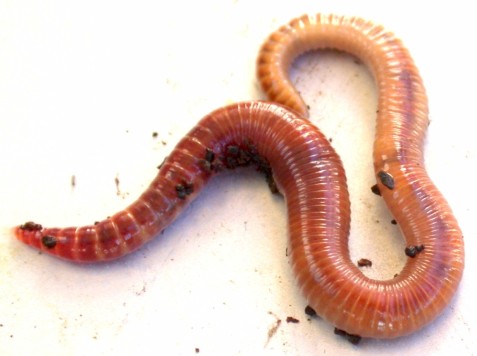My mother gave my husband a brilliant gift for Father's Day - composting worms. 1000 Eisenia Foetidae or Red Wrigglers, to be exact. She ordered them from Uncle Jim's Worm Farm at the same time she bought her own worms and composter.
Reading the instructions, I realized for the first time that composting worms are different from your standard earthworm. I'd been popping worms from my yard into my growbeds, assuming that was "good enough." Hasn't hurt, but it seems red wrigglers will work even better.
A few benefits of worms in aquaponics:
1) They turn scraps into rich, fertile compost. The stuff is called "worm castings," but it's worm poop. Manure on a micro scale. [I wonder if worms are considered "animals" for the purposes of granting food safety certification. Since they're cold blooded, they don't harbor e.coli in their guts any more than do fish.]
2) No need to wash your grow media after initial system setup. The worms will clear out left over roots and stuff.
3) Supplemental food for your fish. Worms double their population in short order (90 days, if I remember correctly). They stop reproducing when they reach the maximum sustainable density, so their is no worry that they will start spilling out all over. But this rapid population growth and/or population replacement means you can snag out a few from time to time as a treat for your fish without worrying that you are fundamentally damaging the efficacy of your worm population to process compost.
4) A worm population in your grow beds can keep your system working between batches of fish. In fact, some folks rely entirely on worms for their ammonia source. This is referred to as Vermiponics. Alas, vermiponics appears to be a new movement, to the point where there isn't even a wikipedia article describing vermiponics and its history.
A downside of worms is their need for bedding material and decomposing scraps. On the other hand, I produce more than enough paper and cardboard as a byproduct of modern life to keep my worms happy.
Now that I know regular earthworms aren't as "good" as red wrigglers for composting, I've started taking to tipping found worms into my fish tank, where I used to tip them into my growbeds. It's been gratifying to see the enthusiasm with which fish consume the worms, even dead and slightly dessicated worms.
Next biological enhancement to the system will be black soldier fly larvae - they should be en route right now. Should be fun!

How would you introduce paper or cardboard to your growbed?
ReplyDeleteNo need to introduce the bedding material into the growbed itself. There are plenty of micro-organisms in a cycled aquaponics growbed for the fish to eat.
ReplyDeleteThe bedding material would be for the separate composting bins, where I put my kitchen scraps.